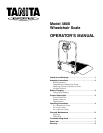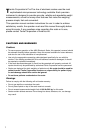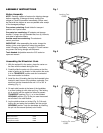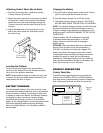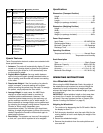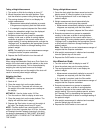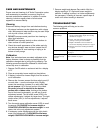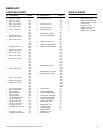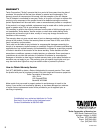
Taking a Weight Measurement
1. Once the chair weight has been zeroed out and the
display reads “0,” have the patient sit on the chair.
2. The moving dashes will lock in and display the
patient’s weight.
3. Weight measurement should automatically be
displayed on the control panel box console.
• Measurement automatically defaults to pounds. If
kilograms are required, push the Kilos switch.
• If a reweigh is required, depress the Zero switch.
4. Excessive movement may prevent a repeatable
reading. In this case, a series of moving dashes
continues to appear on the console rather than a
weight reading. If moving dashes persist, activate the
“Average Lock” by depressing the appropriate Pounds
or Kilos switch to obtain an average reading of the
patient’s weight.
Note: This reading is now an instantaneous average of
weights that the computer calculates.
5. After weight measurement is obtained and recorded,
have the patient step off the scale.
6. Depress the On/Off switch to turn scale off.
As a Stand-on Scale
1. Turn the scale on. Wait for display to read “0.”
2. Have the patient step onto the scale platform.
3. The moving dashes will lock in and display the
patient’s weight.
• Measurement automatically defaults to pounds. If
kilograms are required, push the Kilos switch.
• If a reweigh is required, push the Zero switch.
Note: This reading is now an instantaneous average of
weights that the computer calculates.
4. Excessive movement may prevent a repeatable
reading. In this case, a series of moving dashes
continues to appear on the console rather than a
weight reading. If the moving dashes persist, activate
the “Average Lock” by depressing the appropriate
Pounds or Kilos switch to obtain an average reading of
the patient’s weight.
5. After weight measurement is obtained and recorded,
have the patient step off the scale.
6. Depress the On/Off switch to turn scale off.
Taking a Weight Measurement
1. Turn scale on. Wait for the display to show “0.”
2. Wheel the patient onto the scale platform. Then
lock the wheels to prevent rolling during weighing.
3. The moving dashes will lock in and display the
weight measurement.
• Measurement automatically defaults to pounds.
If kilograms are required, push the Kilos switch.
• If a reweigh is required, depress the Zero switch.
4. Deduct the wheelchair weight from the displayed
weight to obtain the patient’s weight.
5. Excessive movement may prevent a repeatable
reading. In this case, a series of moving dashes
continues to appear on the console rather than a
weight reading. If moving dashes persist, activate the
“Average Lock” by depressing the appropriate Pounds
or Kilos switch to obtain an average reading of the
patient’s weight.
NOTE: This reading is now an instantaneous average
of weights that the computer calculates.
6. Depress the On/Off switch to turn the scale off.
As a Chair Scale
When using the Wheelchair Scale as a Chair Scale, the
weight of the chair used to seat the patient on the scale
must be taken into account. This is accomplished by
weighing the chair by itself to zero-out its weight.
Failure to correctly zero out the weight of the chair will
result in incorrect patient weight readings.
Weighing the Chair
METHOD 1 – Use for any size chair
1. Scale is off.
2. Place the empty chair on the scale platform.
3. Turn the scale on. The scale will now zero out
the weight of the chair leaving a zero reading on
the display.
METHOD 2 – Use for chairs under 12.5 lbs.
1. Turn the scale on. Wait for display to read zero.
2. Place the empty chair on the scale platform. The
display will read the chair’s weight.
3. Depress the Zero button to zero out the weight of
the chair. The display should read “0” again.
NOTE: The Zero button has a dual function. If the
weight of the chair is greater than 12.5 lbs., the scale
will reweigh the chair instead of zeroing it out when
the button is depressed. IN THIS CASE, YOU MUST
USE METHOD 1 TO ZERO OUT THE WEIGHT OF
THE CHAIR.
5



